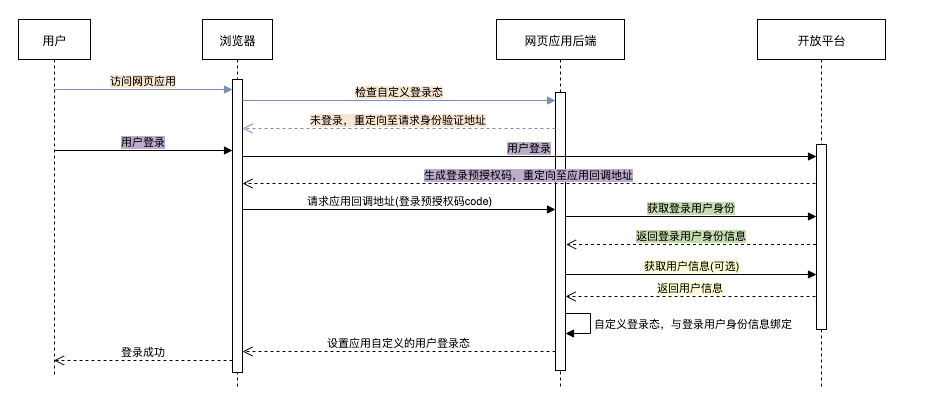
飞书是字节跳动旗下一款企业级协同办公软件,本文将介绍如何基于飞书开放平台的身份验证能力,使用 Lua 实现企业级组织架构的登录认证网关。
<!--more-->
## 登录流程
让我们首先看一下飞书第三方网站免登的整体流程:
第一步: 网页后端发现用户未登录,请求身份验证;
第二步: 用户登录后,开放平台生成登录预授权码,302跳转至重定向地址;
第三步: 网页后端调用获取登录用户身份校验登录预授权码合法性,获取到用户身份;
第四步: 如需其他用户信息,网页后端可调用获取用户信息(身份验证)。

## Lua 实现
### 飞书接口部分实现
#### 获取应用的 access_token
```lua
function _M:get_app_access_token()
local url = "https://open.feishu.cn/open-apis/auth/v3/tenant_access_token/internal/"
local body = {
app_id = self.app_id,
app_secret = self.app_secret
}
local res, err = http_post(url, body, nil)
if not res then
return nil, err
end
if res.status ~= 200 then
return nil, res.body
end
local data = json.decode(res.body)
if data["code"] ~= 0 then
return nil, res.body
end
return data["tenant_access_token"]
end
```
#### 通过回调 code 获取登录用户信息
```lua
function _M:get_login_user(code)
local app_access_token, err = self:get_app_access_token()
if not app_access_token then
return nil, "get app_access_token failed: " .. err
end
local url = "https://open.feishu.cn/open-apis/authen/v1/access_token"
local headers = {
Authorization = "Bearer " .. app_access_token
}
local body = {
grant_type = "authorization_code",
code = code
}
ngx.log(ngx.ERR, json.encode(body))
local res, err = http_post(url, body, headers)
if not res then
return nil, err
end
local data = json.decode(res.body)
if data["code"] ~= 0 then
return nil, res.body
end
return data["data"]
end
```
#### 获取用户详细信息
获取登录用户信息时无法获取到用户的部门信息,故这里需要使用登录用户信息中的 `open_id` 获取用户的详细信息,同时 `user_access_token` 也是来自于获取到的登录用户信息。
```lua
function _M:get_user(user_access_token, open_id)
local url = "https://open.feishu.cn/open-apis/contact/v3/users/" .. open_id
local headers = {
Authorization = "Bearer " .. user_access_token
}
local res, err = http_get(url, nil, headers)
if not res then
return nil, err
end
local data = json.decode(res.body)
if data["code"] ~= 0 then
return nil, res.body
end
return data["data"]["user"], nil
end
```
### 登录信息
#### JWT 登录凭证
我们使用 JWT 作为登录凭证,同时用于保存用户的 `open_id` 和 `department_ids`。
```lua
-- 生成 token
function _M:sign_token(user)
local open_id = user["open_id"]
if not open_id or open_id == "" then
return nil, "invalid open_id"
end
local department_ids = user["department_ids"]
if not department_ids or type(department_ids) ~= "table" then
return nil, "invalid department_ids"
end
return jwt:sign(
self.jwt_secret,
{
header = {
typ = "JWT",
alg = jwt_header_alg,
exp = ngx.time() + self.jwt_expire
},
payload = {
open_id = open_id,
department_ids = json.encode(department_ids)
}
}
)
end
-- 验证与解析 token
function _M:verify_token()
local token = ngx.var.cookie_feishu_auth_token
if not token then
return nil, "token not found"
end
local result = jwt:verify(self.jwt_secret, token)
ngx.log(ngx.ERR, "jwt_obj: ", json.encode(result))
if result["valid"] then
local payload = result["payload"]
if payload["department_ids"] and payload["open_id"] then
return payload
end
return nil, "invalid token: " .. json.encode(result)
end
return nil, "invalid token: " .. json.encode(result)
end
```
#### 使用 Cookie 存储登录凭证
```lua
ngx.header["Set-Cookie"] = self.cookie_key .. "=" .. token
```
### 组织架构白名单
我们在用户登录时获取用户的部门信息,或者在用户后续访问应用时解析登录凭证中的部门信息,根据设置的部门白名单,判断用户是否拥有访问应用的权限。
```lua
-- 部门白名单配置
_M.department_whitelist = {}
function _M:check_user_access(user)
if type(self.department_whitelist) ~= "table" then
ngx.log(ngx.ERR, "department_whitelist is not a table")
return false
end
if #self.department_whitelist == 0 then
return true
end
local department_ids = user["department_ids"]
if not department_ids or department_ids == "" then
return false
end
if type(department_ids) ~= "table" then
department_ids = json.decode(department_ids)
end
for i=1, #department_ids do
if has_value(self.department_whitelist, department_ids[i]) then
return true
end
end
return false
end
```
### 更多网关配置
同时支持 IP 黑名单和路由白名单配置。
```lua
-- IP 黑名单配置
_M.ip_blacklist = {}
-- 路由白名单配置
_M.uri_whitelist = {}
function _M:auth()
local request_uri = ngx.var.uri
ngx.log(ngx.ERR, "request uri: ", request_uri)
if has_value(self.uri_whitelist, request_uri) then
ngx.log(ngx.ERR, "uri in whitelist: ", request_uri)
return
end
local request_ip = ngx.var.remote_addr
if has_value(self.ip_blacklist, request_ip) then
ngx.log(ngx.ERR, "forbided ip: ", request_ip)
return ngx.exit(ngx.HTTP_FORBIDDEN)
end
if request_uri == self.logout_uri then
return self:logout()
end
local payload, err = self:verify_token()
if payload then
if self:check_user_access(payload) then
return
end
ngx.log(ngx.ERR, "user access not permitted")
self:clear_token()
return self:sso()
end
ngx.log(ngx.ERR, "verify token failed: ", err)
if request_uri ~= self.callback_uri then
return self:sso()
end
return self:sso_callback()
end
```
## 使用
本文就不赘述 OpenResty 的安装了,可以参考我的另一篇文章[《在 Ubuntu 上使用源码安装 OpenResty》](https://k8scat.com/posts/linux/install-openresty-on-ubuntu-from-source-code/)。
### 下载
```bash
cd /path/to
git clone git@github.com:ledgetech/lua-resty-http.git
git clone git@github.com:SkyLothar/lua-resty-jwt.git
git clone git@github.com:k8scat/lua-resty-feishu-auth.git
```
### 配置
```conf
lua_package_path "/path/to/lua-resty-feishu-auth/lib/?.lua;/path/to/lua-resty-jwt/lib/?.lua;/path/to/lua-resty-http/lib/?.lua;/path/to/lua-resty-redis/lib/?.lua;/path/to/lua-resty-redis-lock/lib/?.lua;;";
server {
access_by_lua_block {
local feishu_auth = require "resty.feishu_auth"
feishu_auth.app_id = ""
feishu_auth.app_secret = ""
feishu_auth.callback_uri = "/feishu_auth_callback"
feishu_auth.logout_uri = "/feishu_auth_logout"
feishu_auth.app_domain = "feishu-auth.example.com"
feishu_auth.jwt_secret = "thisisjwtsecret"
feishu_auth.ip_blacklist = {"47.1.2.3"}
feishu_auth.uri_whitelist = {"/"}
feishu_auth.department_whitelist = {"0"}
feishu_auth:auth()
}
}
```
### 配置说明
- `app_id` 用于设置飞书企业自建应用的 `App ID`
- `app_secret` 用于设置飞书企业自建应用的 `App Secret`
- `callback_uri` 用于设置飞书网页登录后的回调地址(需在飞书企业自建应用的安全设置中设置重定向 URL)
- `logout_uri` 用于设置登出地址
- `app_domain` 用于设置访问域名(需和业务服务的访问域名一致)
- `jwt_secret` 用于设置 JWT secret
- `ip_blacklist` 用于设置 IP 黑名单
- `uri_whitelist` 用于设置地址白名单,例如首页不需要登录认证
- `department_whitelist` 用于设置部门白名单(字符串)
### 应用权限说明
- 获取部门基础信息
- 获取部门组织架构信息
- 以应用身份读取通讯录
- 获取用户组织架构信息
- 获取用户基本信息
## 开源
本项目已完成且已在 GitHub 上开源:[k8scat/lua-resty-feishu-auth](https://github.com/k8scat/lua-resty-feishu-auth),希望大家可以动动手指点个 Star,表示对本项目的肯定与支持!
有疑问加站长微信联系(非本文作者))





